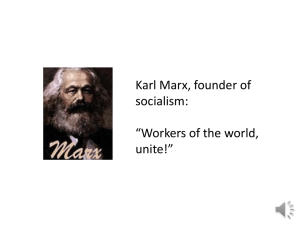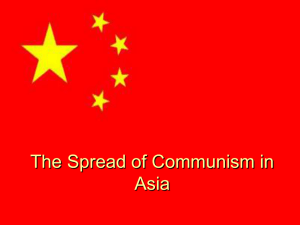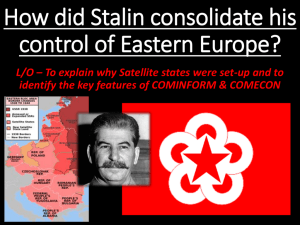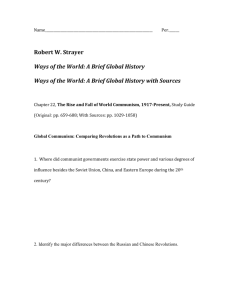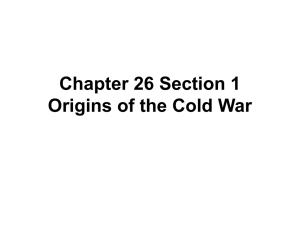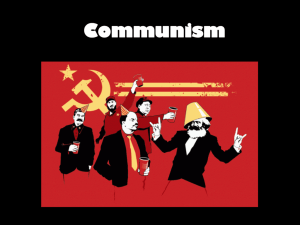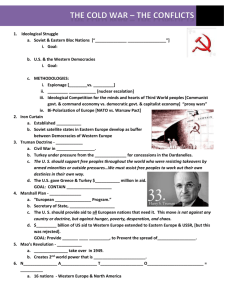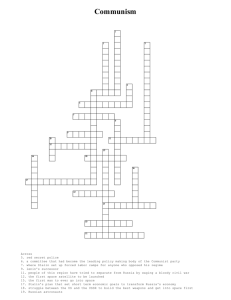cold war key features
advertisement
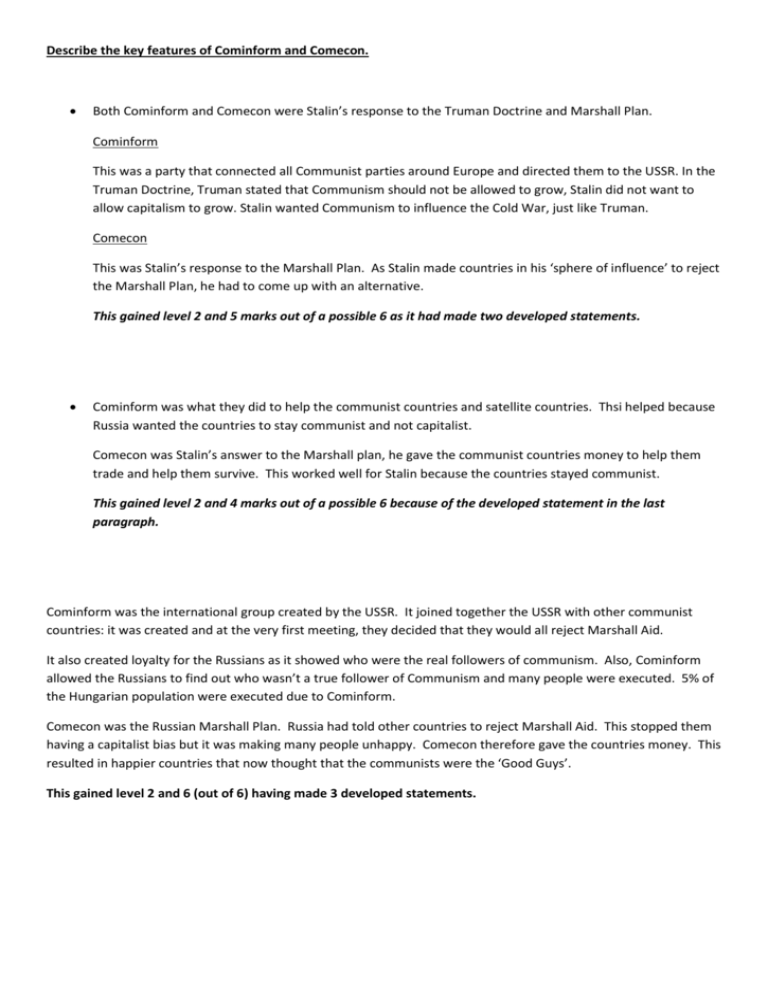
Describe the key features of Cominform and Comecon. Both Cominform and Comecon were Stalin’s response to the Truman Doctrine and Marshall Plan. Cominform This was a party that connected all Communist parties around Europe and directed them to the USSR. In the Truman Doctrine, Truman stated that Communism should not be allowed to grow, Stalin did not want to allow capitalism to grow. Stalin wanted Communism to influence the Cold War, just like Truman. Comecon This was Stalin’s response to the Marshall Plan. As Stalin made countries in his ‘sphere of influence’ to reject the Marshall Plan, he had to come up with an alternative. This gained level 2 and 5 marks out of a possible 6 as it had made two developed statements. Cominform was what they did to help the communist countries and satellite countries. Thsi helped because Russia wanted the countries to stay communist and not capitalist. Comecon was Stalin’s answer to the Marshall plan, he gave the communist countries money to help them trade and help them survive. This worked well for Stalin because the countries stayed communist. This gained level 2 and 4 marks out of a possible 6 because of the developed statement in the last paragraph. Cominform was the international group created by the USSR. It joined together the USSR with other communist countries: it was created and at the very first meeting, they decided that they would all reject Marshall Aid. It also created loyalty for the Russians as it showed who were the real followers of communism. Also, Cominform allowed the Russians to find out who wasn’t a true follower of Communism and many people were executed. 5% of the Hungarian population were executed due to Cominform. Comecon was the Russian Marshall Plan. Russia had told other countries to reject Marshall Aid. This stopped them having a capitalist bias but it was making many people unhappy. Comecon therefore gave the countries money. This resulted in happier countries that now thought that the communists were the ‘Good Guys’. This gained level 2 and 6 (out of 6) having made 3 developed statements. Describe the key features of the Berlin Blockade The key features of the Berlin Blockade was Stalin blocked off all of Berlin and was going to let it starve so no supplies could get in or out. So the British sent around 1.5 million tons of food and other supplies into Berlin in the 318 days it lasted. Level 2 and 4 marks out of 6. It does just make 1 developed statement. The Berlin Blockade was set up to stop East Germans getting into West Germany they wanted to stop all contact between both sides. Key features to it were to help improve West Germany out of Natzism and make it into a much stronger and more economically developed than the east. This gained 0 out of 6 – confused! The Berlin Blockade happened when the Russians encircled Berlin and stopped any supplies entering or leaving. They managed to do this because they owned the part of Germany that Berlin was located in, so it was within their rights to do so. The Americans overcame this blockade by using planes to airlift supplies into Berlin, as the blockade was having a bad affect on the Civilians, causing poverty and hunger. The Berlin airlift was a huge morale booster for the Berliners, and it made the Americans look good. This gained level 2 and 5 marks out of a possible 6 as it had made two developed statements. SECTION 5 – THREE COLD WAR CRISES Briefly explain the key features of the Bay of Pigs invasion, 1961 The leader of Cuba, Fidel Castro was the communist leader of Cuba. He soon made an alliance with the USSR and this left American President J.F. Kennedy very uneasy, as Cuba is an island that is extremely close to the Americans’ South East coast. Kennedy and the C.I.A. made a plan to try and overthrow Castro and his communist government. They gathered some Cuban refugees and trained them for an invasion. Kennedy thought that the Cuban people were unhappy and would join this invasion in order to overthrow Castro. When the Cuban refugees arrived at the Bay of Pigs, the Cuban people fought back, and Kennedy’s plan was a disaster. Within 2 days the Cuban refugees were pulled out of Cuba, and Kennedy was left looking stupid after a huge miscalculation of the Cuban people’s views. This gained level 2 and 6 marks (out of 6) having made 3 developed statements. The key feature of the Bay of Pigs invasion was the plan to overthrow Fidel Castro, who became leader of Cuba after Batista was overthrown. Castro was very anti-capitalist and failed to co-operate with the USA. Kennedy, the American president planned to overthrow him by sending American troops over to Cuba to fight him. Another key feature of the Bay of Pigs invasion was how disastrously it failed. Kennedy hadn’t expected the support from the Cubans for Castro, who had help defeat the American troops in a matter of days. This worried Kennedy as Cuba used to be an ally but was soon turning into an enemy. The third key feature of the Bay of Pigs is who Castro allied with. After the invasion had failed Castro was worried another attempt to invade may happen again and turned to Khrushchev for help. Khrushchev was more than happy to help as he saw this as an opportunity to test Kennedy’s patience, thus leading to the placing of Russian missiles in Cuba. This gained level 2 and 6 marks (out of 6) having made 3 developed statements (even with the error of American troops rather than Cuban refugees). Briefly explain the key features of the Soviet invasion of Czechoslovakia, 1968 The most significant reason as to why Soviet troops invaded Czechoslovakia in 1968 was because Czech’s wanted to leave the Warsaw Pact. This Warsaw Pact was alike to NATO, the American version. Czechoslovakia did no longer want to be communist however Stalin obviously did not approve, Stalin determined Soviet troops went into Czech and invade. USA, Britain and France condomned, they knew it was wrong but did nothing. This was given level 1 and 2 marks (out of 6) for making 2 simple statements (one in the middle paragraph and one in the last statement). It makes mistakes – not least Stalin still being alive in 1968! Communist rule was unpopular in Czechoslovakia, a satellite state of the USSR. The Secret Police crushed all political opposition and the economy suffered under the rule of communist leader, Novotny. Alexander Dubcek was the popular secretary for the Czech communist party and he became the leader of Czechoslovakia in 1968. His reforms, including making political opposition legal and allowing some capitalist profitmaking activities, were known as the Prague Spring. Dubcek wanted a new type of communism for Czechoslovakia, he called it ‘Socialism with a human face’. Brezhnev warned Dubcek about his actions but Dubcek refused to back down. AS a result, in August 1968, Soviet troops invaded Czechoslovakia to restore communist control. Dubcek told the Czechs not to fight the invading troops and the only opposition was a group of students standing in front of Soviet tanks holding anti-invasion banners. Dubcek was forced to reverse his reforms. The US and UN condemned the USSR but offered no aid to the Czechs. Communists outside the USSR were angry about the Soviet actiona dn some turned to China for Communist leadership whilst others set up a rival form of communism; Eurocommunism. Dubcek’s reforms were a problem for the USSR who did not want this kind of challenge to their authority to spread. Brezhnev said that any satellite state threatening the security of the Eastern Bloc would be invaded. This was known as the Brezhnev doctrine. This gained level 2 and 6 marks (out of 6) having made 3 developed statements. NOTE THAT IT HAD ALREADY MADE 6 MARKS BY THE END OF THE 3RD PARAGRAPH SO COULD HAVE STOPPED THERE. SECTION 6 – THE END OF THE COLD WAR Note that we’ve not covered these questions for Section 6 yet Briefly explain the key features of the Intermediate Nuclear Forces Treaty (INF), 1987 The INF Treaty was drawn up at the Rejavik summit in 1986 and was signed in 1987. It instructed that no intermediate range nuclear weapons, with ranges between 500km – 5500km were to be used. This was the first time that the arms race had begun to reverse and proved that the two sides were able to work together to produce good results. It was a major turning point in the end of the Cold War. Also when it was being drawn up it allowed Reagan and Gorbachev to talk one on one which no other cold leaders have previously done. This helped to develop the relationship needed to end the Cold War. This gained level 2 and 6 marks (out of 6) having made 3 developed statements. Briefly explain the key features of the collapse of the Warsaw Pact in 1991 The Warsaw Pact collapsed in the same year as the Soviet Union collapsed, 1991. It was a military alliance between the communist countries of the Eastern Bloc. One of the main reasons for its collapse was the conversion from communism to capitalism in many Eastern European countries. Hungary, Poland, East Germany and Czechoslovakia were some of the countries that broke away from communism and held free elections in the years 1989 to 1991. Once these countries had broken away from communism they could no longer be part of the Warsaw Pact as this was a Pact created to protect communist states from the threat of the West. As the countries were no longer communist, the Pact wasn’t viable, as the West was no longer a threat to these countries now that they were a democracy. This gained level 2 and 5 marks out of a possible 6 as it had made two developed statements.
